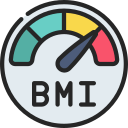Introduction
When it comes to assessing your fitness and overall health, two common metrics often come into play: Body Mass Index (BMI) and Body Fat Percentage. Both offer insights into your body composition, but they do so in different ways. In this article, we will explore the differences between BMI and Body Fat Percentage and determine which one is more accurate in evaluating your health and fitness.
Understanding BMI
BMI is a widely used measure that calculates your body’s relative weight based on your height and weight. The formula for BMI is:
- In metric units: BMI = weight (kg) ÷ height2 (meters)
- In US units: BMI = weight (lb) ÷ height2 (inches) * 703
The resulting number is then categorized into ranges, including underweight, normal weight, overweight, and obese. While BMI provides a general assessment of weight-related health, it doesn’t take into account factors such as muscle mass or body fat.
Assessing Body Fat Percentage
Body Fat Percentage, on the other hand, provides a more direct measure of the amount of fat in your body relative to your total weight. This measurement considers not only your weight and height but also the composition of your body in terms of fat mass and lean mass. Body Fat Percentage is often measured using specialized tools like skinfold calipers or bioelectrical impedance scales.
The Accuracy Debate
The accuracy of BMI in assessing an individual’s health has been a subject of debate in recent years. Critics argue that BMI doesn’t differentiate between fat and muscle mass, leading to misclassifications. For instance, athletes with high muscle mass may be classified as overweight or obese according to their BMI, even if they have a low percentage of body fat.
Body Fat Percentage: A Closer Look
Body Fat Percentage provides a more comprehensive view of your body composition. It accounts for muscle mass and helps distinguish between healthy and excess fat. A lower Body Fat Percentage is generally associated with better health and fitness.
Which Metric is More Accurate?
The accuracy of BMI and Body Fat Percentage depends on your specific goals and context. Here’s a breakdown of when each metric may be more appropriate:
- BMI: BMI is a quick and simple tool for estimating weight-related health on a population level. It’s suitable for identifying potential weight-related health risks in a broad sense. However, it may not be accurate for athletes, bodybuilders, or individuals with unusual body compositions.
- Body Fat Percentage: Body Fat Percentage is more accurate for assessing individual health and fitness goals. It provides a direct measurement of body fat, making it a valuable tool for those striving to optimize their body composition. It’s particularly useful for athletes, fitness enthusiasts, and those looking to track their progress over time.
Conclusion
In the BMI vs. Body Fat Percentage debate, the answer depends on your specific needs. If you’re looking for a quick and straightforward assessment of your weight-related health, BMI can provide valuable insights. However, if you want a more accurate picture of your body composition and are focused on fitness goals, Body Fat Percentage is the superior metric.
Ultimately, it’s essential to consider both BMI and Body Fat Percentage in the context of your individual health and fitness journey. These metrics, when used together, can provide a well-rounded understanding of your body composition and overall well-being.
